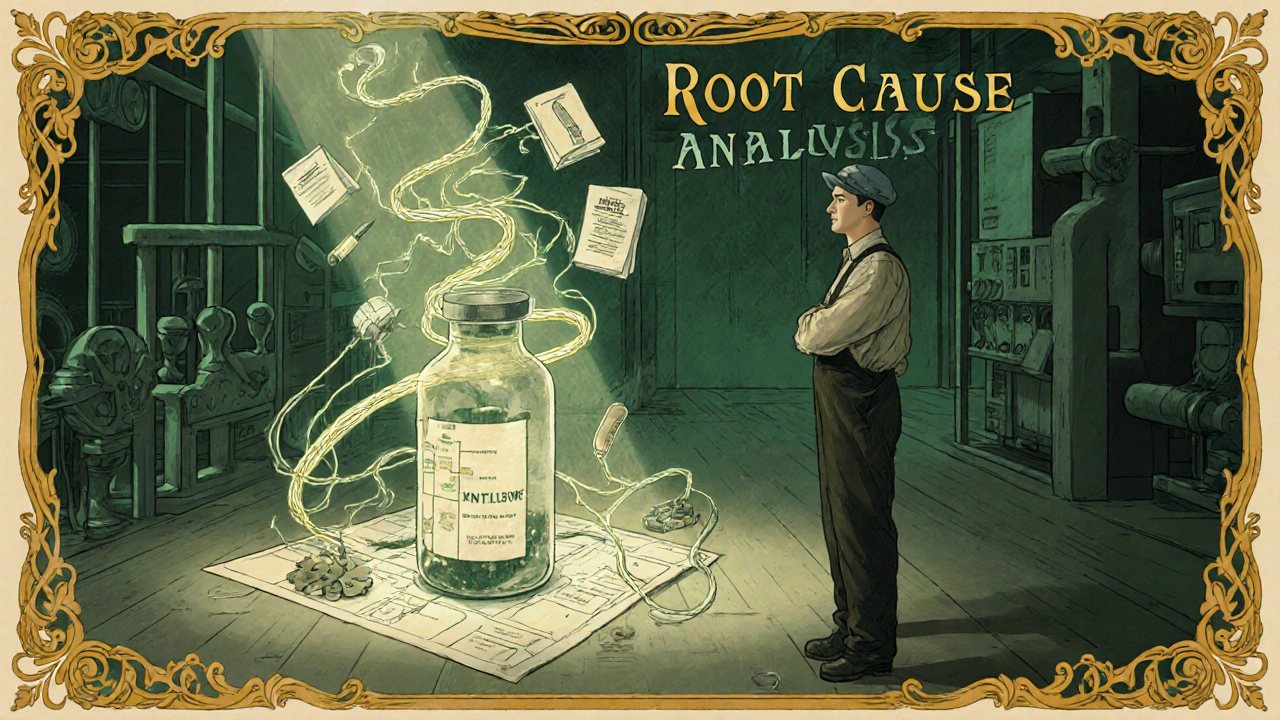When a manufacturer discovers a batch of defective parts, a mislabeled medicine vial, or a medical device that fails testing, they don’t just fix the immediate problem. They dig deeper. That’s because stopping the line for a quick fix isn’t enough - it’s just a bandage. What they need is a corrective action - a structured, documented process to find out why the problem happened in the first place and make sure it never happens again.
What’s the Difference Between a Correction and a Corrective Action?
A correction is a quick fix. You see a misprinted label? You reprint it. A machine is off by 0.2mm? You adjust the setting. That’s a correction. It fixes the symptom, not the cause. A corrective action is different. It asks: Why did the label get printed wrong? Was it a training gap? A faulty sensor? A misconfigured software setting? Was the same mistake made three times last month and ignored? The FDA and ISO 13485 require manufacturers - especially in medical devices and pharmaceuticals - to prove they’re doing more than just correcting. They need to show they’ve eliminated the root cause. In fact, 61% of companies inspected by the FDA in 2022 failed because they only corrected, never corrected the cause.The Six-Step Corrective Action Process
Manufacturers don’t guess their way through quality problems. They follow a clear, repeatable process, often called CAPA - Corrective and Preventive Action. Here’s how it works in practice:- Identify the problem - It starts with data. A quality inspector flags a batch. A customer returns a device. A machine sensor triggers an alert. The issue is logged with exact details: what, when, where, and how many.
- Evaluate the risk - Not all defects are equal. A slightly crooked label on a vitamin bottle? Low risk. A loose screw in a pacemaker? Critical. Manufacturers use risk matrices to decide how urgent and serious the action needs to be.
- Find the root cause - This is where most failures happen. Teams use tools like the 5 Whys or Fishbone diagrams. For example: Why did the vial leak? → Seal failed. Why? → Pressure was too high. Why? → Machine setting wasn’t updated after changeover. Why? → Operator wasn’t trained on the new protocol. Why? → Training records weren’t reviewed after process update. Root cause: poor change control.
- Plan the fix - Once the cause is known, the team writes a plan. It includes: who will do what, by when, and how they’ll know it worked. No vague statements like “improve training.” Instead: “Update training module by 11/15, retrain 12 operators by 11/20, verify 100% compliance via audit.”
- Implement the solution - The plan goes live. New procedures are posted. Software is updated. Equipment is recalibrated. Training happens. All changes are documented and signed off.
- Verify effectiveness - This is the make-or-break step. The manufacturer must prove the fix works. They run 30+ new units. They track defect rates for 2-3 production cycles. They check statistical process control charts. If the defect rate drops from 2.8% to 0.4% - like one automotive supplier did - then the CAPA is successful.
What Makes a Corrective Action Fail?
Many companies have CAPA systems on paper. Few have them working well. Here’s why most fail:- They skip root cause analysis - 57% of failed CAPAs, according to FDA data, never truly identified the real cause. They blamed “operator error” and moved on. That’s lazy.
- No verification - If you don’t test the fix, you’re just hoping. Without data showing defect rates dropped, the action is meaningless.
- Too much paperwork, too little action - One Reddit user said their CAPA generated 47 pages per issue. That’s not compliance - that’s paralysis. The best systems are digital, automated, and lean.
- No ownership - If no one’s named as responsible, nothing gets done. Accountability is non-negotiable.

Why CAPA Matters More Than Ever
Regulations are tightening. The FDA’s new QMSR (Quality Management System Regulation) in 2024 demands clearer proof of effectiveness. ISO 13485 now requires manufacturers to track trends - not just individual defects. If the same type of error pops up three times in a month, that’s not coincidence. It’s a systemic problem. And it demands a corrective action. In medical device manufacturing, 82% of companies have formal CAPA systems. In pharma, it’s 76%. These aren’t optional. They’re the price of staying in business. In 2023, CAPA-related issues made up 28% of all FDA quality observations - second only to document control failures.How Technology Is Changing CAPA
Gone are the days of paper logs and Excel spreadsheets. Leading manufacturers are using digital platforms that:- Auto-trigger CAPAs when a defect threshold is crossed
- Link root cause analysis to real-time machine data
- Use AI to spot patterns across hundreds of past incidents

What Works in Real Factories
Successful CAPA systems share common traits:- Cross-functional teams - Quality, production, engineering, and maintenance all sit in the same room. Silos kill root cause analysis.
- Clear metrics - “Reduce defects by 50% in 3 cycles” is measurable. “Improve quality” is not.
- Leadership buy-in - If managers don’t review CAPA status weekly, it becomes a checkbox exercise.
- Simple, not perfect - The best systems aren’t the most complex. They’re the ones people actually use.
When Is CAPA Overkill?
Not every manufacturer needs a full-blown CAPA system. A small batch producer making custom metal brackets with low defect rates might only need corrections and simple logs. But if you’re making anything regulated - medicine, implants, automotive parts, aerospace components - CAPA isn’t a luxury. It’s the law. The cost of skipping it? Far higher than the cost of doing it right. A single recall can cost millions. A warning letter can shut down production for months.What’s the difference between corrective action and preventive action?
Corrective action fixes something that already went wrong. Preventive action stops something from going wrong before it happens. For example, if a machine keeps overheating and you fix it after each failure - that’s corrective. If you install a new cooling system because historical data shows overheating is likely - that’s preventive.
How long does a corrective action take to complete?
It depends on the problem. A simple labeling error might take 3-5 days. A complex root cause - like a flawed design or training gap - can take 6-12 weeks. The FDA expects timely action, but doesn’t rush the process. What matters is thoroughness, not speed.
Do small manufacturers need CAPA systems?
If they’re regulated - yes. Even small medical device makers must comply with FDA 21 CFR Part 820 or ISO 13485. The system can be scaled down - fewer forms, simpler reviews - but the core steps (identify, analyze, fix, verify) still apply. Ignoring it risks inspections, fines, or worse.
What’s the most common mistake in CAPA implementation?
Treating symptoms instead of root causes. Blaming “human error” without asking why the human made that error. Was the procedure unclear? Was the tool hard to use? Was training outdated? The real problem is rarely the person - it’s the system they’re working in.
Can CAPA reduce costs?
Yes. Companies that run effective CAPA systems see up to 37% less downtime, 28% higher customer satisfaction, and 19% lower operational costs. Why? Fewer recalls, less scrap, fewer reworks, and smoother audits. It’s an investment that pays back fast.


11 Comments
So let me get this straight: 61% of companies fail FDA inspections because they fix symptoms instead of root causes? And you're surprised? This isn't a quality issue-it's a cultural one. Lazy management. No accountability. Just slap a band-aid on it and call it a day. Pathetic.
CAPA my ass. Most of these systems are just paperwork pyramids. 47 pages for a mislabeled bottle? Bro. I’ve seen guys fix a machine with a zip tie and a duct tape and it ran better for 6 months. Sometimes the ‘root cause’ is just someone being tired. Stop over-engineering everything.
This is actually really helpful. I work in a small med device shop and we’ve been struggling with CAPA. The part about verifying effectiveness really clicked-I never realized we were just checking boxes instead of measuring real results. Thanks for laying this out so clearly.
OMG I LOVE THIS POST so much like I literally cried when I read the part about the Ohio company fixing their changeover process like??? Who even are these heroes??? I need to print this and hang it on my wall like right now
I think what’s really important here is that people forget that CAPA isn’t just for big companies or fancy labs, it’s about making sure that the person who’s putting together the device or the pill or whatever doesn’t have to worry about making a mistake because the system is set up to help them not fail, you know? Like it’s not about blaming people it’s about building something that’s kind of like a safety net so that even if someone has a bad day or forgets something the process still catches it before it goes out the door and hurts someone, and that’s actually really beautiful if you think about it
The AI-powered root cause analysis stat blew my mind. 52% faster investigations? That’s not just efficiency-that’s liberation. Imagine getting your team out of spreadsheets and into solving real problems. This is the future, and it’s already here.
In India we dont even have proper documentation for basic stuff. You think CAPA? We struggle with who took the last coffee mug. You want root cause? Its always 'human error'. No one asks why the human wasnt trained. Or why the machine wasnt maintained. Or why the manager never checked. Its always the worker. Sad.
I appreciate how this post highlights that CAPA isn’t about perfection-it’s about practicality. The best systems I’ve seen are the ones that don’t require a PhD to use. Simple, clear, owned by someone. That’s all it takes to make real change.
I’ve worked in factories where CAPA was just a checkbox. But I’ve also seen teams turn it around-when engineering and production sat in the same room, no more blame games. Just solutions. The real magic isn’t in the software-it’s in the conversations.
You know what’s worse than bad CAPA? When the manager says 'we already did a CAPA on this' but the same problem happens again next week. And they act like they did their job. I swear, half the time they just copy-paste the last report and change the date. It’s not compliance. It’s theater.
Let’s be real: CAPA is the corporate equivalent of therapy for broken systems. And most companies are the type that show up to therapy, say 'I’m fine,' and leave. Meanwhile, the real issue-their toxic culture of blame-is still screaming in the background. 28% of FDA observations? That’s not a statistic. That’s a funeral.